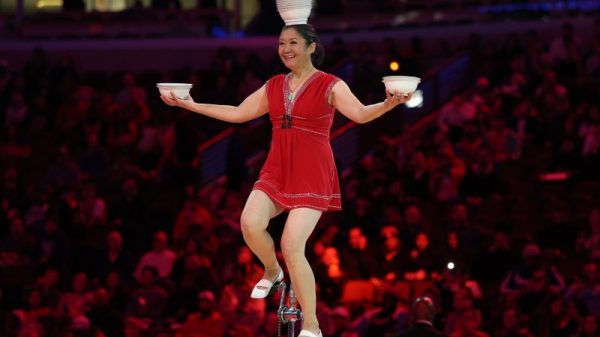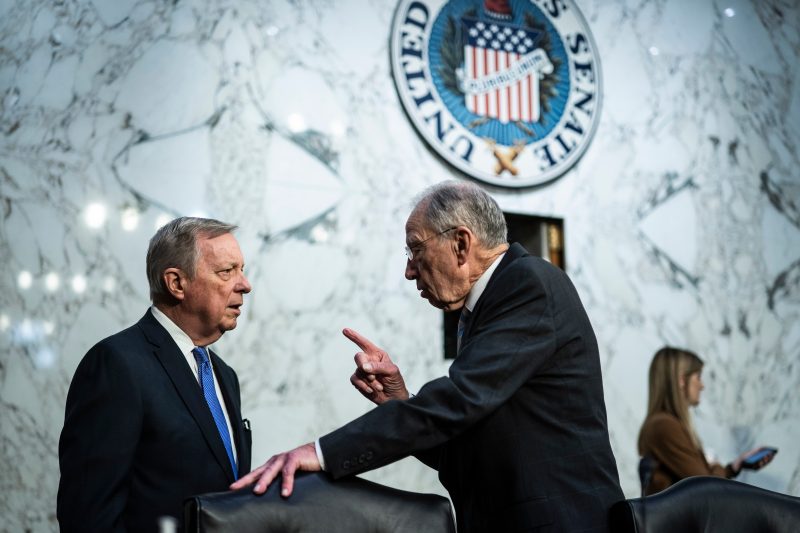For almost nine months before his death in 2018, Sen. John McCain (R-Ariz.) could not lead the Senate Armed Services Committee in person, deferring to a colleague to serve as acting chairman.
For more than a year before his 2009 death, Sen. Edward M. Kennedy (D-Mass.) deputized several Democrats to run his Senate committee to oversee writing the Affordable Care Act and several other key legislative items.
But those two lions of the Senate served in a recent-but-different era. Their absences never impacted the outcome of a judicial confirmation and they never faced calls to resign the way Sen. Dianne Feinstein (D-Calif.) has in recent weeks.
So long as Feinstein, 89, remains in San Francisco, recuperating from complications of her shingles diagnosis seven weeks ago, the Senate Judiciary Committee has a 10-10 membership. Only more moderate nominees with some GOP support can advance to the full Senate for confirmation.
And in today’s Senate, with its almost bizarre focus on judicial wars, that puts a spotlight on Feinstein. For decades, the occasional high-profile battles over the Supreme Court drew national attention, but now the Senate is consumed with skirmishes over lower federal courts, whose controversial rulings can create a national stir. Just look at the fallout from a Texas district judge’s decision earlier this month to invalidate an abortion medication’s regulatory approval.
With Republicans taking the House majority in January, meaning little legislative work Senate Democrats would support was headed their way, they expected to spend a vast amount of their time trying to reverse Republican gains made in the federal courts during the Donald Trump’s administration.
Of the first 45 roll-call votes held in the Senate this year, from early January through early March, 37 involved judicial nominees.
This modern Senate is an almost complete transmogrification of the Founding Fathers’ original intent for what used to be considered the world’s most deliberative body.
Rather than debate, amend and then pass legislation on the most important issues of the day, Congress often just deadlocks and refuses to find legislative compromise on big issues such as immigration, gun violence and abortion rights. Instead, presidents — both Democratic and Republican — issue executive actions that prompt lawsuits that are battled out first at the district courts, then circuit courts of appeal and ultimately the Supreme Court.
This legislative atrophy, particularly over the last decade, raises the stakes on trying to stack as many friendly jurists onto the federal bench whenever your party controls the White House and Senate.
“Judges are perceived as political actors, and so they become a political football. So that’s a tragedy in my view,” Sen. John Cornyn (R-Tex.), a senior member of the Judiciary Committee, said Tuesday.
Cornyn noted how the order protecting undocumented immigrants from deportation if they were brought here as children, issued in 2013 by President Barack Obama, is still bouncing around the federal courts.
“I don’t know where it is, in the 5th Circuit or the Supreme Court. And, here we are, 10 years or more, after the fact,” he said.
Senior Judiciary Democrats saw the rejection of Feinstein’s request for a temporary replacement as part of the long conservative effort to control the judiciary.
“If you think of the Supreme Court as a prize ship that has been captured by big powerful interests, and is now being sailed in their service, you can understand why anything that interfered with [Republicans’] operation of their prize would be a huge problem for them,” Sen. Sheldon Whitehouse (D-R.I.) said Tuesday.
Whitehouse surmised that if Feinstein had requested leave from one of her other committees, such as Appropriations or Intelligence, Republicans would not have objected because those traditionally bipartisan panels do not impact the judiciary.
“No,” he said. “This is all about control over the court and judges and turning that branch of government into a political weapon for a bunch of creepy billionaires.”
There are already 18 judicial nominees in the queue for confirmation before the full Senate, including five to the more powerful circuit courts. A simple majority vote, if all 50 members of the Democratic caucus are united, can confirm these judges even with Feinstein’s current absence.
That’s probably more than three weeks worth of floor time for Senate Majority Leader Charles E. Schumer (D-N.Y.) to schedule to clear the judicial decks, making Feinstein’s absence since early March not too impactful.
But there’s a palpable, unspoken concern among Democrats that she could be out much longer — both McCain and Kennedy went stretches of more than six months without casting a vote. And that would leave the most liberal-leaning jurists stuck in committee, needing Feinstein’s tiebreaking vote to advance.
“Listen, she’s a remarkable person and a close friend. I wish her well and I hope she comes back soon. But we’re anxiously awaiting her return,” said Sen. Richard J. Durbin (D-Ill.), chairman of the Judiciary Committee.
Feinstein, in line to become committee chair when Democrats took the majority in early 2021, stepped aside for Durbin to take charge.
Her friends believe Feinstein faces a double-standard that did not apply to McCain, Kennedy and other male senators whose health faded such as the late Robert C. Byrd (D-W.Va.) and Thad Cochran (R-Miss.).
“I think Dianne has been mistreated by some in the Senate who tolerated health problems that affected male senators for years,” Sen. Susan Collins (R-Maine) said Tuesday.
But those men lost their bearings at a time when the Senate did not devote so much time to confirming judges and other executive branch posts, most of which were confirmed without a roll call.
In the 111th Congress — when Kennedy missed most of the first eight months of 2009 until his death, and when Byrd missed long stretches in 2010 until his death — less than 9 percent of Senate votes came on nominations.
By the 116th Congress, more than 71 percent of all Senate votes came on judicial and executive branch nominations, according to databases compiled by Derek Willis, a former investigative reporter who now teaches journalism at the University of Maryland.
The dramatic change came in 2013 when Majority Leader Harry M. Reid (D-Nev.) grew tired of Minority Leader Mitch McConnell’s blockade of key circuit court nominees and used an unprecedented party-line move to change rules to allow confirmations on simple majority margins.
Republicans returned fire by drawing out almost every procedural vote even on nominees with bipartisan backing, and in early 2016, after conservative Supreme Court justice Antonin Scalia died, Republicans rallied around McConnell’s decision to refuse to even consider letting Obama appoint a successor.
After Trump’s victory, McConnell (R-Ky.) used those four years as majority leader to focus on confirming judges, including three to the Supreme Court.
When Democrats took full control two years ago, President Biden set out to reshape the courts. Even with an ambitious legislative agenda taking up large amounts of floor time, Schumer held almost 60 percent of all roll calls on nominations in 2021-2022.
And early this year, the Senate confirmed Biden’s 100th judicial nominee, at a quicker pace than Trump or Obama reached that marker.
So, with a divided Congress, Democrats want to accelerate that judicial train because it’s easier to do than trying to forge bipartisan legislation that still needs to clear a 60-vote filibuster hurdle.
“That’s the one thing that Democrats thought they could do,” Cornyn said of judges. “But obviously with the vacancy, that’s no longer the case, at least as long as that lasts.”



























